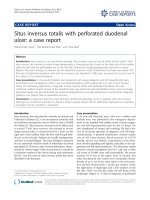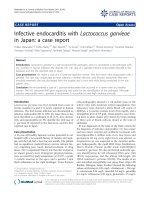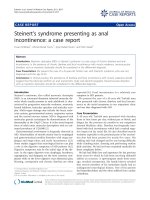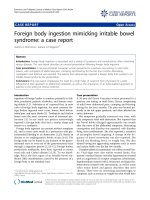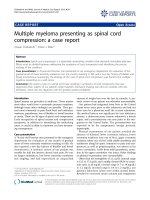Báo cáo y học: " Esophageal intramural pseudodiverticulosis characterized by barium esophagography: a case report" pdf
Bạn đang xem bản rút gọn của tài liệu. Xem và tải ngay bản đầy đủ của tài liệu tại đây (372.7 KB, 2 trang )
JOURNAL OF MEDICAL
CASE REPORTS
O'Connor et al. Journal of Medical Case Reports 2010, 4:145
/>Open Access
CASE REPORT
BioMed Central
© 2010 O'Connor et al; licensee BioMed Central Ltd. This is an Open Access article distributed under the terms of the Creative Commons
Attribution License ( which permits unrestricted use, distribution, and reproduction in
any medium, provided the original work is properly cited.
Case report
Esophageal intramural pseudodiverticulosis
characterized by barium esophagography: a case
report
Owen J O'Connor*
1
, Adrian Brady
1
, Fergus Shanahan
2
, Eamonn Quigley
2
, Michael O'Riordain
3
and Michael M Maher
1
Abstract
Introduction: Esophageal intramural pseudodiverticulosis is a rare condition characterized by the dilatation of the
submucosal glands.
Case presentation: We present a case of esophageal intramural pseudodiverticulosis in a 72-year-old Caucasian man
who presented with dysphagia and with a background history of alcohol abuse. An upper gastrointestinal endoscopy
of our patient showed an esophageal stricture with abnormal mucosal appearances, but no malignant cells were seen
at biopsy. Appearances on a barium esophagram were pathognomonic for esophageal intramural
pseudodiverticulosis.
Conclusion: We demonstrate the enduring usefulness of barium esophagography in the characterization of abnormal
mucosal appearances at endoscopy.
Introduction
Esophageal intramural pseudodiverticulosis is a rare con-
dition characterized by the dilatation of submucosal
glands. Based on approximately 250 cases reported to
date, this condition is slightly more common in men than
in women [1,2]. Intramural pseudodiverticulosis is most
commonly associated with gastrooesophageal reflux and
esophagitis and less commonly with alcoholism, diabetes
mellitus, Crohn's disease, tuberculosis, Mallory-Weiss
syndrome and achalasia [3,4]. The average age at presen-
tation is 54 years and patients typically present with dys-
phagia, which is frequently associated with stricture
formation, as in case we describe here [3,4]. Symptoms
usually respond well to anti-inflammatory medication
and balloon dilatation of strictures.
Case presentation
A 72-year-old Caucasian man (height: 170 cm, weight: 85
kg) presented with a 4-year history of mild dysphagia for
solid foods. His medical history was notable for alcohol
abuse and associated alcoholic hepatitis. An upper gas-
trointestinal endoscopy was initially performed on our
patient. At endoscopy, a stricture of the mid-esophagus
with numerous tiny erythematous macules on the
mucosal surface was seen (Figure 1). There was clinical
uncertainty about the cause of the stricture and the
mucosal appearances. A barium esophagogram was per-
formed (Figures 2A and 2B). Barium esophagogram dem-
onstrated a smooth stricture of the mid-esophagus with
numerous small (2 mm to 4 mm), flask-shaped outpouch-
ings of the esophageal wall, an appearance which is
pathognomonic for esophageal intramural pseudodiver-
ticulosis [5].
Discussion
Biphasic esophagography is generally recommended for
the evaluation of an esophageal stricture. While a single
contrast barium esophagogram provides maximal esoph-
ageal dilatation and is useful for the depiction of a stric-
ture, a double contrast examination allows accurate
imaging of the esophageal mucosa and wall. Barium
esophagram is valuable for establishing this particular
diagnosis as reports in the literature have suggested that
the diverticular orifices are detected at endoscopy in only
20% of patients [2].
* Correspondence:
1
Department of Radiology, Mercy University Hospital, Cork, Ireland
Full list of author information is available at the end of the article
O'Connor et al. Journal of Medical Case Reports 2010, 4:145
/>Page 2 of 2
Conclusion
This case demonstrates the enduring usefulness of bar-
ium esophagography in the characterization of peculiar
mucosal appearances at endoscopy.
Consent
Written informed consent was obtained from our patient
for publication of this case report and any accompanying
images. A copy of the written consent is available for
review by the Editor-in-Chief of this journal.
Competing interests
The authors declare that they have no competing interests.
Authors' contributions
OJOC prepared the manuscript. MOR performed upper gastrointestinal endos-
copy. AB and MM performed barium esophagography. FS and EQ medically
managed our patient. All authors read and approved the final manuscript.
Author Details
1
Department of Radiology, Mercy University Hospital, Cork, Ireland,
2
Department of Medicine, University College Cork, Cork, Ireland and
3
Department of Surgery, Mercy University Hospital, Cork, Ireland
References
1. VanLaer W, Urbain D, Reynaert H: Esophageal intramural
pseudodiverticulosis. Clin Gastroenterol Hepatol 2007, 5(12):A22.
2. Herter B, Dittler HJ, Wuttge-Hannig A, Siewert JR: Intramural
pseudodiverticulosis of the esophagus: a case series. Endoscopy 1997,
29:109-113.
3. Flora KD, Gordon MD, Lieberman D, Schmidt W: Esophageal intramural
pseudodiverticulosis. Dig Dis 1997, 15:113-119.
4. Bhattacharya S, Mahmud S, McGlinchey I, Schmidt W: Intramural
pseudodiverticulosis of esophagus. Surg Endosc 2002, 16:714-715.
5. Luedtke P, Levine MS, Rubesin SE, Weinstein DS, Laufer I: Radiologic
diagnosis of benign esophageal strictures: a pattern approach.
Radiographics 2003, 23(4):897-909.
doi: 10.1186/1752-1947-4-145
Cite this article as: O'Connor et al., Esophageal intramural pseudodiverticu-
losis characterized by barium esophagography: a case report Journal of Med-
ical Case Reports 2010, 4:145
Received: 3 December 2009 Accepted: 21 May 2010
Published: 21 May 2010
This article is available from: 2010 O'Co nnor et al; licens ee BioMed Central Ltd. This is an Open Access article distributed under the terms of the Creative Commons Attribution License ( which permits unrestricted use, distribution, and reproduction in any medium, provided the original work is properly cited.Journal of Medical Case Repo rts 2010, 4:145
Figure 1 Endoscopic image of the esophagus. The pseudodivertic-
ular orifices appear as multiple erythematous macules on the surface
of the esophagus.
Figure 2 Barium oesophagram. (A) There are numerous barium-
filled diverticula of the mid- and lower esphagus. (B) There is lack of
distension of the mid-esophagus, thus indicating the presence of a
stricture.





